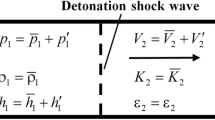Abstract
The effects of air dissociation on flat-plate hypersonic boundary-layer flow instability and transition prediction are studied. The air dissociation reactions are assumed to be in the chemical equilibrium. Based on the flat-plate boundary layer, the flow stability is analyzed for the Mach numbers from 8 to 15. The results reveal that the consideration of air dissociation leads to a decrease in the unstable region of the first-mode wave and an increase in the maximum growth rate of the second mode. High frequencies appear earlier in the third mode than in the perfect gas model, and the unstable region moves to a lower frequency region. When the Mach number increases, the second-mode wave dominates the transition process, and the third-mode wave has little effect on the transition. Moreover, when the Mach number increases from 8 to 12, the N-factor envelope becomes higher, and the transition is promoted. However, when the Mach number exceeds 12, the N-factor envelope becomes lower, and the transition is delayed. The N-factor envelope decreases gradually with the increase in the altitude or Mach number.
Similar content being viewed by others
References
CHANG, C. L., VINH, H., and MALIK, M. R. Hypersonic boundary-layer stability with chemical reactions using PSE. 28th Fluid Dynamics Conference, Snowmass Village (1994)
MACK, L. M. Boundary-Layer Stability Theory, Springer, Berlin Heidelberg (1969)
MACK, L. M. Linear stability theory and the problem of supersonic boundary-layer transition. AIAA Journal, 13, 278–289 (1975)
MALIK, M. R. and ANDERSON, E. C. Real gas effects on hypersonic boundary-layer stability. Physics of Fluids A: Fluid Dynamics, 3, 803–821 (1991)
HUDSON, M. L., CHOKANI, N., and CANDLER, G. V. Linear stability of hypersonic flow in thermochemical nonequilibrium. AIAA Journal, 35, 958–964 (1997)
MA, Y. B. and ZHONG, X. L. Direct numerical simulation of instability of nonequilibrium reacting hypersonic boundary layers. 38th Aerospace Sciences Meeting and Exhibit, Reno, U. S. A. (2000)
PRAKASH, A. and ZHONG, X. L. Numerical simulation of planetary reentry aeroheating over blunt bodies with non-equilibrium reacting flow and surface reactions. 47th AIAA Aerospace Sciences Meeting Including the New Horizons Forum and Aerospace Exposition, Orlando, Florida (2009)
MORTENSEN, C. H. and ZHONG, X. L. Simulation of second-mode instability in a real-gas hypersonic flow with graphite ablation. AIAA Journal, 52, 1632–1652 (2014)
MARXEN, O., IACCARINO, G., and SHAQFEH, E. Hypersonic boundary-layer instability with chemical reactions. 48th AIAA Aerospace Sciences Meeting Including the New Horizons Forum and Aerospace Exposition, Orlando (2010)
MARXEN, O., IACCARINO, G., and MAGIN, T. E. Direct numerical simulations of hypersonic boundary-layer transition with finite-rate chemistry. Journal of Fluid Mechanics, 755, 35–49 (2014)
MARXEN, O., IACCARINO, G., and SHAQFEH, E. Numerical simulation of hypersonic boundary-layer instability using different gas models. Annual Research Briefs, 2007, 15–27 (2007)
MORTENSEN, C. H. and ZHONG, X. L. Real-gas and surface-ablation effects on hypersonic boundary-layer instability over a blunt cone. AIAA Journal, 54, 980–998 (2016)
FAN, M., CAO, W., and FANG, X. J. Prediction of hypersonic boundary layer transition with variable specific heat on plane flow. Science China, 54, 2064–2070 (2011)
JOHNSON, H. B., SEIPP, T. G., and CANDLER, G. V. Numerical study of hypersonic reacting boundary layer transition on cones. Physics of Fluids, 10, 2676–2685 (1998)
FAN, Y., WAN, B. B., HAN, Y. F., and LUO, J. S. Hydrodynamic stability and transition prediction with the chemical equilibrium gas model (in Chinese). Journal of Aerospace Power, 7, 1658–1668 (2016)
WAN, B. B., HAN, Y. F., FAN, Y., and LUO, J. S. Effect of transport properties of high-temperature air on boundary layer stability and transition prediction (in Chinese). Journal of Aerospace Power, 10, 188–195 (2017)
GUPTA, R. N., YOS, J. M., THOMPSON, R. A., and LEE, K. P. A Review of Reaction Rates and Thermodynamic and Transport Properties for an 11-Species Air Model for Chemical and Thermal Nonequilibrium Calculations to 30 000 K, National Aeronautics and Space Administration, Hampton (1990)
MALIK, M. R. Numerical methods for hypersonic boundary layer stability. Journal of Computational Physics, 86, 376–413 (1990)
MALIK, M. R. Finite Difference Solution of the Compressible Stability Eigenvalue Problem, NASA Technical Report, National Aeronautics and Space Administration Washington, D. C. (1990)
SALEMI, L. and FASEL, H. F. Linearized Navier-Stokes simulation of the spatial stability of a hypersonic boundary layer in chemical equilibrium. 43rd AIAA Fluid Dynamics Conference, Reno (2013)
ARNAL, D. Boundary layer transition: predictions based on linear theory. Special Course on Progress in Transition Modelling, Agard Lab, Toulouse (1994)
JAFFE, N. A., OKAMURA, T. T., and SMITH, A. M. O. Determination of spatial amplification factors and their application to predicting transition. AIAA Journal, 8, 301–308 (1970)
CHEN, F. J., MALIK, M. R., and BECKWITH, I. E. Boundary-layer transition on a cone and flat plate at Mach 3.5. AIAA Journal, 27, 687–693 (1989)
Author information
Authors and Affiliations
Corresponding author
Additional information
Citation: HAN, Y. F. and CAO, W. Flat-plate hypersonic boundary-layer flow instability and transition prediction considering air dissociation. Applied Mathematics and Mechanics (English Edition) (2019) https://doi.org/10.1007/s10483-019-2480-6
Project supported by the National Natural Science Foundation of China (Nos. 11732011, 11672205, and 11332007) and the National Key Research and Development Program of China (No. 2016YFA0401200)
Rights and permissions
About this article
Cite this article
Han, Y., Cao, W. Flat-plate hypersonic boundary-layer flow instability and transition prediction considering air dissociation. Appl. Math. Mech.-Engl. Ed. 40, 719–736 (2019). https://doi.org/10.1007/s10483-019-2480-6
Received:
Revised:
Published:
Issue Date:
DOI: https://doi.org/10.1007/s10483-019-2480-6




